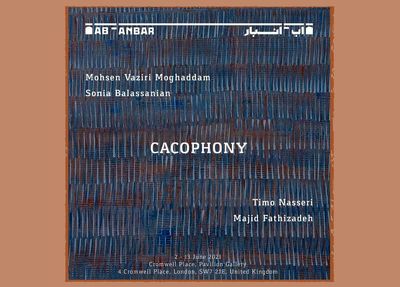The Ab-Anbar Gallery had selected the artworks by Sonia Balassanian, Majid Fathizadeh, Mohsen Vaziri Moghaddam, and Timo Nasseri for the exhibition. The exhibition is part of the Middle Eastern focus week at the Cromwell Place held in association with Abu Dhabi art fair and is timed to coincide with ‘Epic Iran’ at the V&A which also features the work of Timo and 3 other artists from the gallery programme.The exhibit named “Cacophony” will continue until June 13.
Few societies have experienced such a period of rapid modernization as Iran during the last century and the flow of ideas and artists both in and out of the country that this has produced. Whilst all the artists featured in this exhibition have a common Iranian heritage which has informed aspects of their work, it is their Internationalism which shines through and the merging of different cultures towards a quest for a new identity.
This exhibition is about order but ‘order’ as a concept is challenged by an intuitive analysis of ‘chaos’; a state alluded to in the exhibition title ‘Cacophony’ with its direct reference to the eclectic soundscapes utilised in the video and installation-based work of Balassanian. The featured works in Cacophony vary from the very chaotic scenes painted by Fathizadeh and the experimental films of Balassanian – to the precise highly ordered geometrical compositions of Timo’s or Vaziri’s. Balassanian’s paintings stand somewhere in the middle of this spectrum, mediating an orderly/disorderly amalgamation or transformative modes.
Seen as a whole, the works in Cacophony reveal a clear message: there is an embedded chaos within societies and individual civilians; a state of anarchy. Even the most ordered forms or living conditions have concealed states of turmoil within them. This condition is revealed vividly here in some of the works by Balassanian and Fathizadeh but seen in a confrontational yet tamed and ordered way in the works by Vaziri and Nasseri.
Ab-Anbar will host an artist talk by Timo Nasseri as part of the gallery presentation at Cromwell Place.
Cromwell Palace, which has 15 exhibition spaces, will host the Abrakan exhibition in another of its galleries from June 2 to 9, with works by Peyman Barabadi and Babak Al-Ebrahim Dehkordi.
Peyman Barabadi and Babak Alebrahim Dehkordi, both born in 1984, have been working together as the “unified duo” of Peybak since December 20, 2001. They start working on different parts of every piece together, until they both declare it finished. When asked who
feeds into their work, and who is their artistic source, they answer that they have been «influenced by Iranian poets, by stories» and add that they do not possess «any reference». Peybak’s “atemporal works, where the gesture’s energy competes with the stroke’s precision,where the same gets confused with the unique, chaos with order”, are inspired by Persian poetry, mythology and miniature paintings.
Peybak's work has been exhibited by the Dastan Gallery at the Cromwell Palace, and he has previously participated in various solo and group exhibitions in Paris, New York, Geneva and others.
These exhibitions, along with ‘Epic Iran’, occurs at a time where there is a particular interest in contemporary and modern art from Iran and the Middle East and the internationalism that this proliferation of creative voices has fostered.

